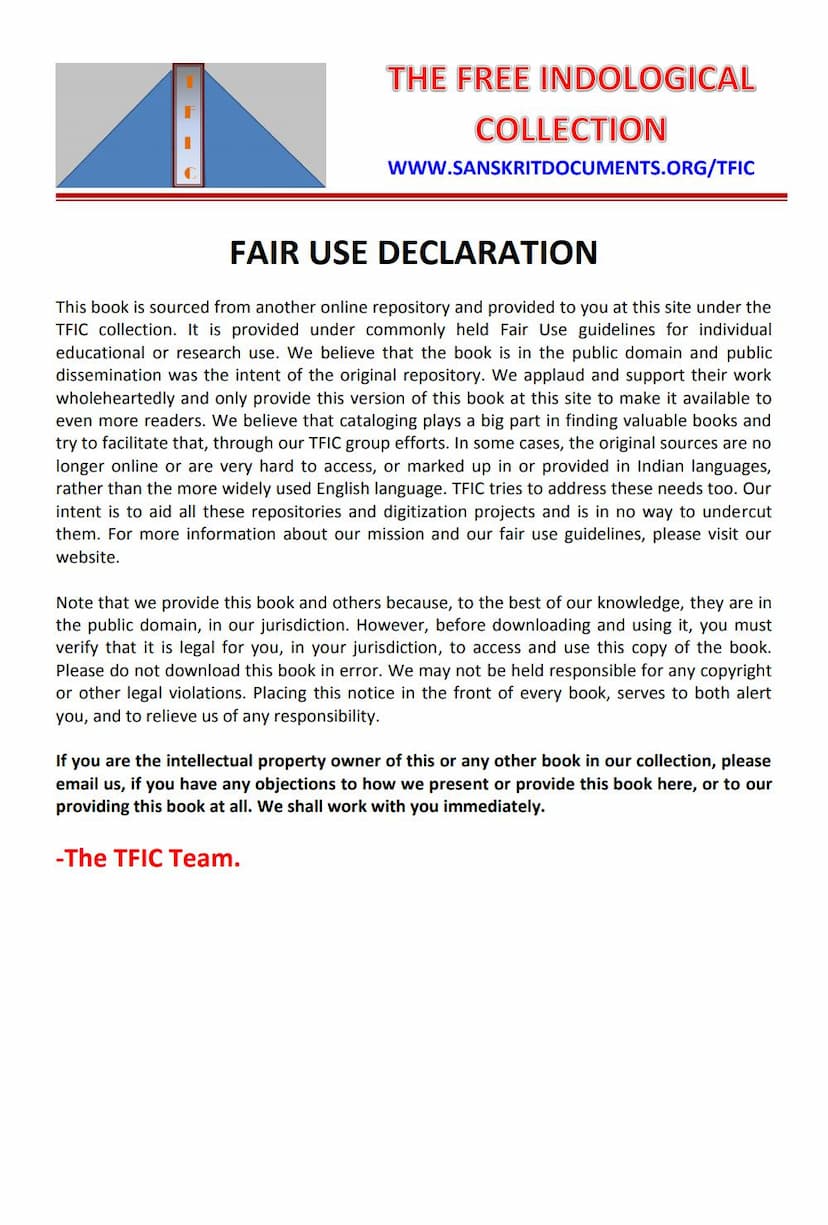Swasamarananda Athwa Chetan Karm Yuddha
Added to library: September 2, 2025

Summary
Here's a comprehensive summary of the Jain text "Swasamarananda athwa Chetan Karm Yuddha" by Shitalprasad, based on the provided pages:
Book Title: Swasamarananda athwa Chetan Karm Yuddha (Self-Bliss or the Battle of Consciousness and Karma) Author: Shitalprasad Publisher: Mulchand Kisandas Kapadia Edition: First Edition, Vira Samvat 2449 (1922 CE)
Overview:
"Swasamarananda athwa Chetan Karm Yuddha" is a profound Jain text that allegorically depicts the spiritual journey of the soul as a fierce battle between the soul's true nature (Chetan or Consciousness) and the forces of Karma. The author, Shitalprasad, uses vivid imagery and a narrative style to illustrate the complex stages of spiritual progress as outlined in Jain philosophy, particularly focusing on the twelve stages of spiritual development (Guna Sthana).
Central Allegory:
The book's core metaphor is the "battle of consciousness and karma."
- Chetan (Consciousness/Soul): Represented as a valiant warrior or a pure, radiant being with inherent infinite knowledge, perception, strength, and bliss. Initially, this warrior is depicted as being enslaved or blinded by ignorance.
- Karma: Personified as the forces of an enemy, a kingdom of delusion (Mohanagar), ruled by the king of delusion (Mohanrupa). This kingdom is populated by armies of various karmic forces (karma senas) led by powerful generals like Mithyatva (false belief) and the four Anantanubandhi Kashayas (long-standing passions of anger, pride, delusion, and greed).
- The Journey: The soul, through the guidance of a wise guide (Vidhyadhar, representing the teachings of the Tirthankaras and scriptures), embarks on a path of self-realization. This involves understanding its true nature, fighting against the influence of karma, gradually overcoming these karmic obstacles, and ultimately achieving liberation (Moksha or Shiva Nagar).
Key Themes and Stages of the Spiritual Battle:
The book systematically walks the reader through the soul's progress, mirroring the Jain Guna Sthanas (stages of spiritual development), often described as battles fought on different fronts with varying strategies and outcomes.
- The Awakening and Initial Guidance: The soul, trapped in the misery of delusion, is awakened by the teachings of a wise guide (Vidhyadhar). The guide reveals the soul's true independent nature and its inherent bliss, urging it to shed false attachments.
- The Battle for Purity: The soul begins to fight against the forces of karma. This involves gaining various "powers" or Labdhis (like Deshana Labdhi - the power of receiving teachings, Prayogya Labdhi - the power of right effort) which enable it to weaken and resist the karmic armies.
- Overcoming Delusion and Passions: The text details how the soul, through practices like right contemplation and ethical conduct, gradually weakens the power of false beliefs (Mithyatva) and the strong, persistent passions (Anantanubandhi Kashayas). This is depicted as stages of Adhahkaran, Apoorva Karan, and Anivartikaran.
- The Stages of Equanimity and Vow-Taking: The soul progresses through stages of mixed perception (Mishra Gunasthana), right belief (Samyak Darshan), and partial vows (Desha Virata). Each stage involves fighting and conquering specific karmic forces.
- The Ascetic Path: The journey intensifies as the soul embraces monasticism (Muni Pada Dharana), leading to stages of carefulness (Pramatta Virata) and vigilant carefulness (Apramatta Virata). These stages involve intense internal battles against subtle karmic influences and the mind's wanderings.
- The Path of Sublimation and Annihilation: The soul then enters the more advanced stages of conquering subtle passions (Sukshma Samparaaya), pacifying mental disturbances (Upaśanta Moha), and ultimately destroying them (Ksheena Moha). These are depicted as climbing spiritual "mountains" or "lines" (श्रेणी - Shreni) where karma is gradually subdued or annihilated.
- The State of Omniscience and Liberation: The final stages describe the soul attaining omniscience (Sayoga Kevali and Ayogi Kevali) and finally becoming a liberated soul (Siddha Paramatma). These are the ultimate victories where the soul is completely free from the shackles of karma, experiencing its inherent Swasamarananda (self-bliss) eternally.
Key Concepts and Terminology:
- Guna Sthana: The twelve stages of spiritual progress, described as different battlegrounds or levels of victory.
- Labdhi: Spiritual powers or achievements that aid the soul in its battle.
- Kashaya: Passions (anger, pride, delusion, greed) that fuel karmic attachment.
- Mithyatva: False belief or delusion, the primary enemy.
- Shiva Nagar/Moksha Nagar: The ultimate goal, the city of liberation.
- Vidhyadhar: The wise guide or spiritual teacher.
- Subh Bhav/Ashubh Bhav: Auspicious and inauspicious mental states, influencing the battle's outcome.
Purpose and Audience:
The book is intended for Jain followers and anyone interested in understanding the spiritual path through a compelling allegorical framework. It aims to inspire readers by illustrating that the soul has the inherent power to overcome karmic obstacles and achieve ultimate bliss. The author encourages readers to study the text repeatedly and spread its message.
Overall Message:
"Swasamarananda athwa Chetan Karm Yuddha" offers a detailed and engaging account of the soul's arduous yet ultimately triumphant struggle against karmic bondage. It emphasizes the power of self-awareness, the importance of following spiritual guidance, the necessity of persistent effort in overcoming internal impurities, and the ultimate reward of eternal bliss and liberation attainable through the Jain path. The book is a spiritual manual disguised as an epic battle, guiding the reader towards the ultimate victory of self-realization and Swasamarananda.